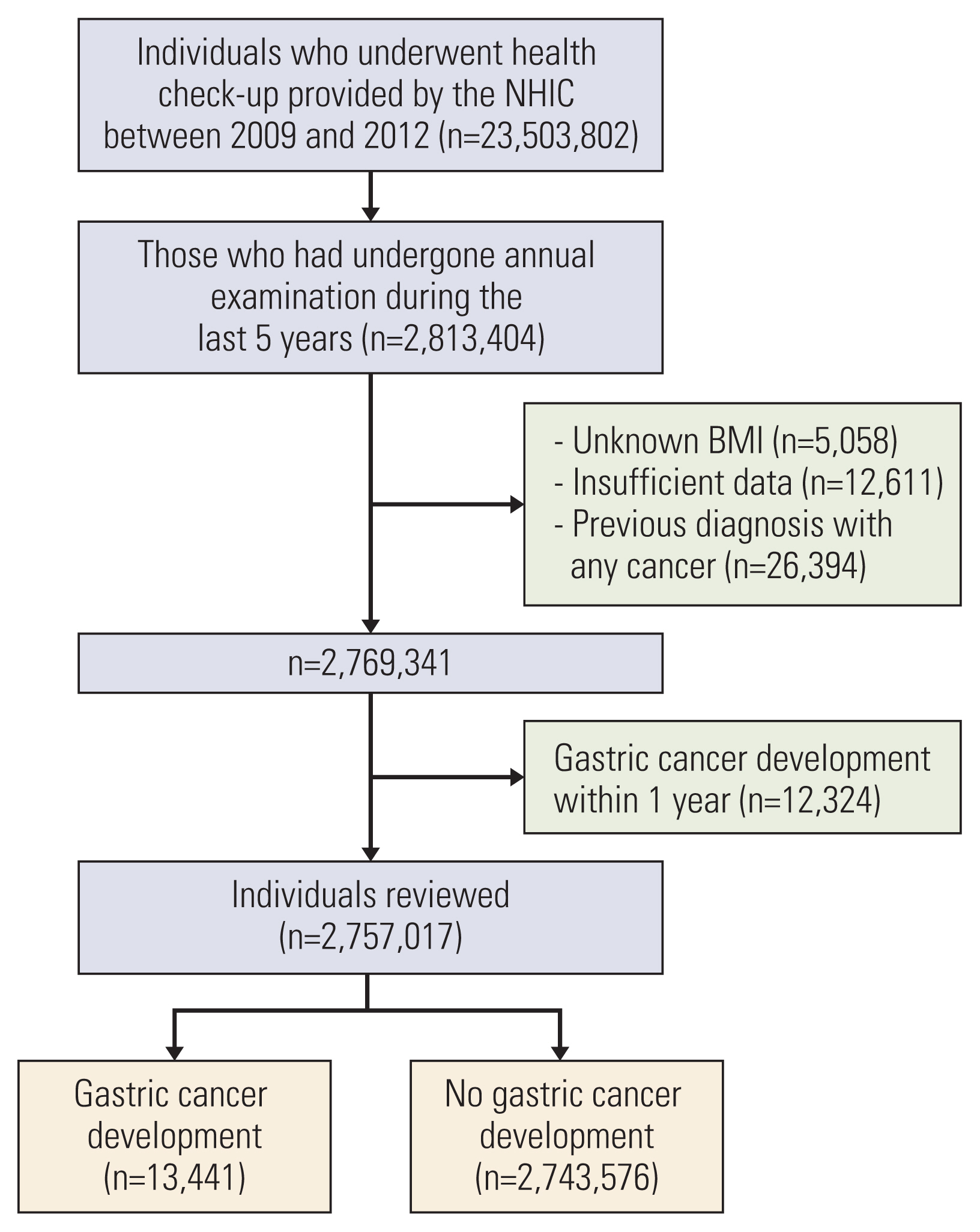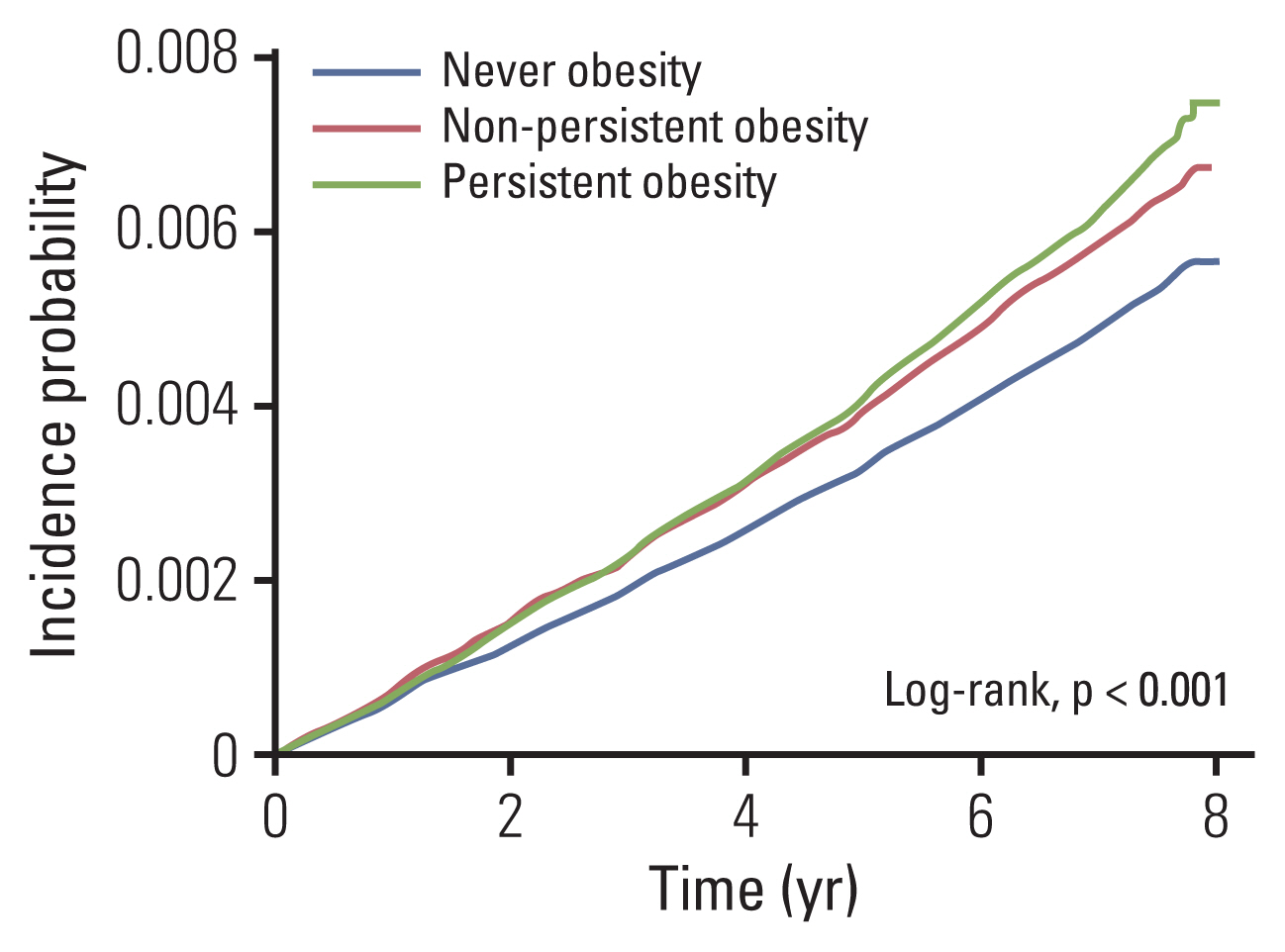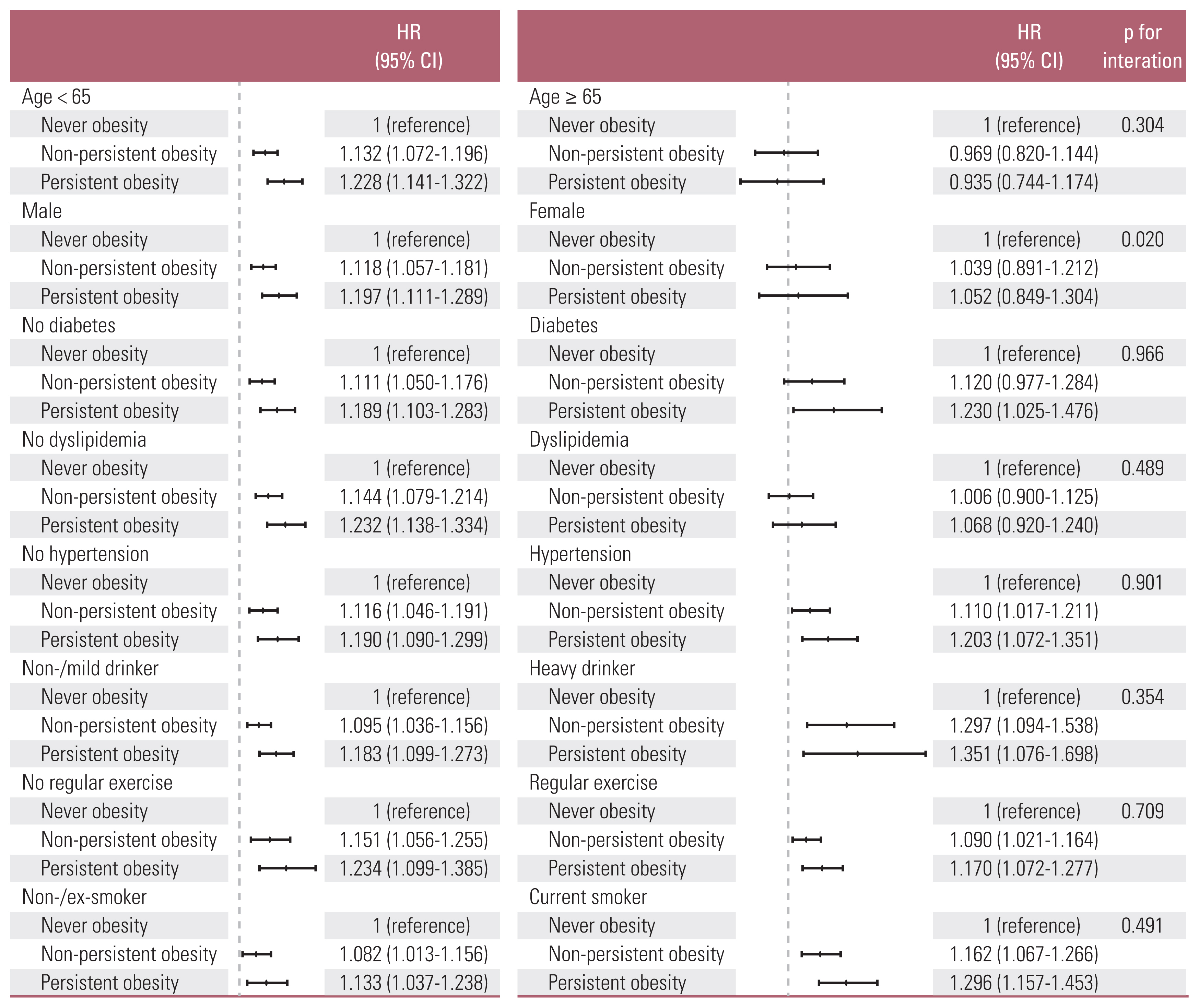Cancer Res Treat.
2022 Jan;54(1):199-207. 10.4143/crt.2021.130.
Association between the Persistence of Obesity and the Risk of Gastric Cancer: A Nationwide Population-Based Study
- Affiliations
-
- 1Department of Internal Medicine, Healthcare Research Institute, Healthcare System Gangnam Center, Seoul National University Hospital, Seoul, Korea
- 2Department of Internal Medicine, Seoul National University Bundang Hospital, Seongnam, Korea
- 3Department of Statistics and Actuarial Science, Soongsil University, Seoul, Korea
- 4College of Medicine, The Catholic University of Korea, Seoul, Korea
- 5Division of Gastroenterology, Department of Internal Medicine, Yonsei University College of Medicine, Seoul, Korea
- KMID: 2524600
- DOI: http://doi.org/10.4143/crt.2021.130
Abstract
- Purpose
There remains controversy about relationship between obesity and gastric cancer. We aimed to examine the association using obesity-persistence.
Materials and Methods
We analyzed a nationwide population-based cohort which underwent health check-up between 2009 and 2012. Among them, those who had annual examinations during the last 5 years were selected. Gastric cancer risk was compared between those without obesity during the 5 years (never-obesity group) and those with obesity diagnosis during the 5 years (non-persistent obesity group; persistent obesity group).
Results
Among 2,757,017 individuals, 13,441 developed gastric cancer after median 6.78 years of follow-up. Gastric cancer risk was the highest in persistent obesity group (incidence rate [IR], 0.89/1,000 person-years; hazard ratio [HR], 1.197; 95% confidence interval [CI], 1.117 to 1.284), followed by non-persistent obesity group (IR, 0.83/1,000 person-years; HR, 1.113; 95% CI, 1.056 to 1.172) compared with never-obesity group. In subgroup analysis, this positive relationship was true among those < 65 years old and male. Among heavy-drinkers, the impact of obesity-persistence on the gastric cancer risk far increased (non-persistent obesity: HR, 1.297; 95% CI, 1.094 to 1.538; persistent obesity: HR, 1.351; 95% CI, 1.076 to 1.698).
Conclusion
Obesity-persistence is associated with increased risk of gastric cancer in a dose-response manner, especially among male < 65 years old. The risk raising effect was much stronger among heavy-drinkers.
Figure
Reference
-
References
1. Bray F, Ferlay J, Soerjomataram I, Siegel RL, Torre LA, Jemal A. Global cancer statistics 2018: GLOBOCAN estimates of incidence and mortality worldwide for 36 cancers in 185 countries. CA Cancer J Clin. 2018; 68:394–424.
Article2. Schistosomes, liver flukes and Helicobacter pylori. In : IARC Working Group on the Evaluation of Carcinogenic Risks to Humans; Lyon. 7–14 June 1994; IARC Monogr Eval Carcinog Risks Hum. 1994. 61:p. 1–241.3. Hisamichi S, Sasaki R, Sugawara N, Yanbo T, Yamagata S. Stomach cancer in various age groups (Japan) as detected by gastric mass survey. J Am Geriatr Soc. 1979; 27:439–43.
Article4. Ladeiras-Lopes R, Pereira AK, Nogueira A, Pinheiro-Torres T, Pinto I, Santos-Pereira R, et al. Smoking and gastric cancer: systematic review and meta-analysis of cohort studies. Cancer Causes Control. 2008; 19:689–701.
Article5. Sung NY, Choi KS, Park EC, Park K, Lee SY, Lee AK, et al. Smoking, alcohol and gastric cancer risk in Korean men: the National Health Insurance Corporation Study. Br J Cancer. 2007; 97:700–4.
Article6. McCullough ML, Robertson AS, Jacobs EJ, Chao A, Calle EE, Thun MJ. A prospective study of diet and stomach cancer mortality in United States men and women. Cancer Epidemiol Biomarkers Prev. 2001; 10:1201–5.7. Shikata K, Kiyohara Y, Kubo M, Yonemoto K, Ninomiya T, Shirota T, et al. A prospective study of dietary salt intake and gastric cancer incidence in a defined Japanese population: the Hisayama study. Int J Cancer. 2006; 119:196–201.
Article8. Buckley MJ, O’Shea J, Grace A, English L, Keane C, Hourihan D, et al. A community-based study of the epidemiology of Helicobacter pylori infection and associated asymptomatic gastroduodenal pathology. Eur J Gastroenterol Hepatol. 1998; 10:375–9.
Article9. Poorolajal J, Moradi L, Mohammadi Y, Cheraghi Z, Gohari-Ensaf F. Risk factors for stomach cancer: a systematic review and meta-analysis. Epidemiol Health. 2020; 42:e2020004.
Article10. Chen Y, Liu L, Wang X, Wang J, Yan Z, Cheng J, et al. Body mass index and risk of gastric cancer: a meta-analysis of a population with more than ten million from 24 prospective studies. Cancer Epidemiol Biomarkers Prev. 2013; 22:1395–408.
Article11. Kim HJ, Kim N, Kim HY, Lee HS, Yoon H, Shin CM, et al. Relationship between body mass index and the risk of early gastric cancer and dysplasia regardless of Helicobacter pylori infection. Gastric Cancer. 2015; 18:762–73.
Article12. Yang P, Zhou Y, Chen B, Wan HW, Jia GQ, Bai HL, et al. Overweight, obesity and gastric cancer risk: results from a meta-analysis of cohort studies. Eur J Cancer. 2009; 45:2867–73.
Article13. Smith GD, Ebrahim S. ‘Mendelian randomization’: can genetic epidemiology contribute to understanding environmental determinants of disease? Int J Epidemiol. 2003; 32:1–22.14. Oh SW. Obesity and metabolic syndrome in Korea. Diabetes Metab J. 2011; 35:561–6.
Article15. Lee SY, Park HS, Kim DJ, Han JH, Kim SM, Cho GJ, et al. Appropriate waist circumference cutoff points for central obesity in Korean adults. Diabetes Res Clin Pract. 2007; 75:72–80.
Article16. Lauby-Secretan B, Scoccianti C, Loomis D, Grosse Y, Bianchini F, Straif K, et al. Body fatness and cancer: viewpoint of the IARC Working Group. N Engl J Med. 2016; 375:794–8.17. Turati F, Tramacere I, La Vecchia C, Negri E. A meta-analysis of body mass index and esophageal and gastric cardia adenocarcinoma. Ann Oncol. 2013; 24:609–17.
Article18. Moschos SJ, Mantzoros CS. The role of the IGF system in cancer: from basic to clinical studies and clinical applications. Oncology. 2002; 63:317–32.
Article19. Chaves J, Saif MW. IGF system in cancer: from bench to clinic. Anticancer Drugs. 2011; 22:206–12.20. Balkwill F, Mantovani A. Inflammation and cancer: back to Virchow? Lancet. 2001; 357:539–45.
Article21. Dalamaga M, Christodoulatos GS, Mantzoros CS. The role of extracellular and intracellular Nicotinamide phosphoribosyl-transferase in cancer: diagnostic and therapeutic perspectives and challenges. Metabolism. 2018; 82:72–87.
Article22. Dalamaga M, Diakopoulos KN, Mantzoros CS. The role of adiponectin in cancer: a review of current evidence. Endocr Rev. 2012; 33:547–94.
Article23. Guan WL, Yuan LP, Yan XL, Yang DJ, Qiu MZ. More attention should be paid to adult gastric cancer patients younger than 35 years old: extremely poor prognosis was found. J Cancer. 2019; 10:472–8.
Article24. Kyrgiou M, Kalliala I, Markozannes G, Gunter MJ, Paraskevaidis E, Gabra H, et al. Adiposity and cancer at major anatomical sites: umbrella review of the literature. BMJ. 2017; 356:j477.
Article25. Murphy N, Strickler HD, Stanczyk FZ, Xue X, Wassertheil-Smoller S, Rohan TE, et al. A prospective evaluation of endogenous sex hormone levels and colorectal cancer risk in postmenopausal women. J Natl Cancer Inst. 2015; 107:djv210.
Article26. Chlebowski RT, Wactawski-Wende J, Ritenbaugh C, Hubbell FA, Ascensao J, Rodabough RJ, et al. Estrogen plus progestin and colorectal cancer in postmenopausal women. N Engl J Med. 2004; 350:991–1004.
Article27. Chen D, Luo W, Guo Z, Wu M, Zhou Z. The impact of interaction between alcohol consumption and obesity on incident hypertension. Zhonghua Yu Fang Yi Xue Za Zhi. 2015; 49:728–32.28. Luo WS, Chen F, Ji JM, Guo ZR. Interaction of tobacco smoking and alcohol consumption with obesity on cardiovascular disease in a Chinese cohort. Coron Artery Dis. 2020; 31:372–7.
Article29. La Vecchia C. Hypothesis: is the fall in Helicobacter pylori related to the global rise in body mass index? Eur J Cancer Prev. 2011; 20:556.30. Kamada T, Hata J, Kusunoki H, Ito M, Tanaka S, Kawamura Y, et al. Eradication of Helicobacter pylori increases the incidence of hyperlipidaemia and obesity in peptic ulcer patients. Dig Liver Dis. 2005; 37:39–43.
Article
- Full Text Links
- Actions
-
Cited
- CITED
-
- Close
- Share
- Similar articles
-
- The Metformin Use and Gastric Cancer Risk
- Corrigendum: Korean Gastric Cancer Association Nationwide Survey on Gastric Cancer in 2014
- Risk of Psoriasis in Postgastrectomy Gastric Cancer Survivors: A Nationwide Population-Based Cohort Study
- Body Mass Index and Risk of Gastric Cancer in Asian Adults:A Meta-Epidemiological Meta-Analysis of Population-BasedCohort Studies
- Risk Factors of Gastric Cancer and Lifestyle Modification for Prevention




